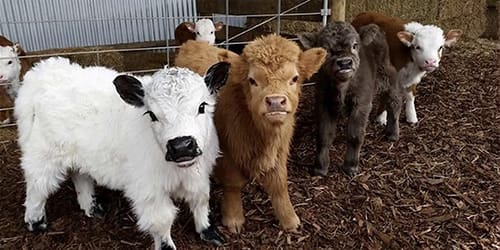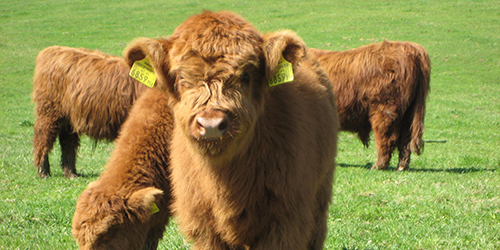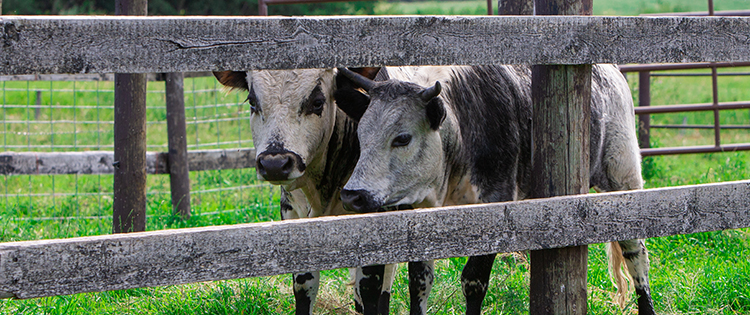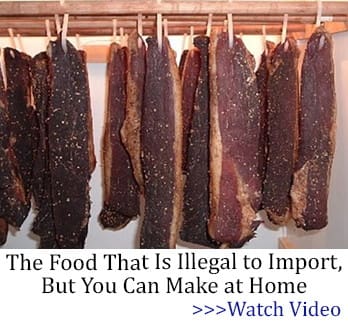There are times in life when being small has its advantages. You need to eat less, you take up less space, and you use fewer resources – all important aspects to consider when keeping a sustainable future in mind. However, we aren’t talking about humans here, but rather mini cows – and your small plot of land will benefit greatly from these smaller, docile bovines.
Cuteness aside, mini cows are a wonderful addition to your family farm or homestead for several reasons. Self-sufficiency and self-reliance are first on the list, followed quickly by the saying that “size matters”. A mini cow will produce less milk and meat, on far less land, than the standard size of the same breed, and that is a good thing when your aim is to produce solely for your family. The quality of milk and meat will remain the same, or even increase, as you are able to provide higher quality pastures that are not overgrazed and over trodden.
Raising miniature cows is growing in popularity as people move back to the land, regaining control of food production and at the same time deciding that enough is enough! With quite a few breeds being on the diminutive side there are plenty of mini cows to choose from: Lowlines or miniature Angus, mini Hereford, mini Zebus, Galloway, Belfairs, Dexters and, of course, miniature Jerseys.
If you have limited pastureland, small acreage, are new to the joys of rearing livestock or simply don’t need vast amounts of milk and meat, then raising a mini cow or two may be the perfect next adventure for you.
Benefits of Raising Mini Cows
If you have been searching for a cow that provides a consistent supply of milk without requiring expensive and excessive amounts of feed, then a mini cow may be just what you are looking for.
The best cow is not always the one that provides you with the most of everything – it is the one that provides you with everything that you need the most. If what you want is gallons and gallons of milk a day then a traditional cow may suit you better, but if land is limited and you still want your gallon of nourishing milk every day, then consider owning a mini cow – their kind demeanor will delight you.
A standard-size, full-grown cow may produce six to seven gallons of milk a day. Unless you are making cheese, that is a lot of milk for a small family! By comparison, mini Jerseys are family-friendly and produce 1.5-3 gallons a day – the perfect amount for enjoying raw milk, fresh cream, sour cream, butter, cheese and other fermented dairy products.

Mini cows have a special way of converting organic feed into choice cuts of meat, and there is a growing demand for lean, grass-fed steaks. One mini cow can feed a small family for months. The amount of meat from a miniature cow may just fill your freezer, without the need to share with another family. When it comes to slaughtering, you might even be able to take on the butcher’s role yourself.
Related: What to Eat When the Power Goes Out
Mini cows are naturally less intimidating than their full-size counterparts. When speaking of miniature Jerseys it is useful to know that they weigh just half as much as a standard Jersey – about 700 pounds. Small-breed cattle are typically one third to half the size of a standard milking cow, ranging in weight from 500 to 800 pounds. A full grown Holstein, by comparison averages 1,500 pounds! That is quite a difference in terms of weight, height and the quantity of feed needed to keep your cow healthy.
Mini cows are said to be 25% more efficient than regular size cattle, meaning that you will only need ⅓ of the standard amount of feed for each head. In a food crisis, or grain shortage, you will still be able to produce top-quality meat on very little land.

To rear standard size cows, you’ll need to provide approximately 1.8 acres per cow, depending on crop rotation and quality of land. The amount of land required by a mini cow is half an acre or a bit more. As they graze and feed at a slower rate, you will be able to rotate your mini cows with greater efficiency.
Getting Started With Mini Cows
Finding, and buying, your first mini cow may be a challenge. It depends on your location and the location of the registered farm. There are several questions to ask as you go along – How much milk do I need? How many mini cows can my land provide food for? How will I transport my new mini cow? Are my fences strong enough to hold them in? Where can I find a miniature milk cow breeder? How tall will my mini cow be when it is fully grown?
Because of their lower weight mini cows will be easier to handle, for children and adults alike. Mini cows will also be easier on fences, too; in many cases an electric fence may be enough. Due to the fact that they eat less per day than their full-size counterparts (a milking cow consumes about 100 pounds of feed each day) you will be able to save money on feed costs, sharing some of the feed distribution with other farm animals: chickens, pigs, ducks and turkeys.
Overall, mini cows are less work than rearing a standard milking cow. Less time spent on animal rearing leaves you with more for gardening, foraging and preserving food for winter.
Just as miniature cows eat less than a full-size cow, you’ll need just ½ – 1 acre of pasture for each cow and you will have less manure to haul away.
Mini cows also drink far less water, an important thing to consider when choosing your milk source. Consider the size/height of the animal and provide appropriate troughs for your cattle.
Embrace the best of both worlds and discover the best, most adorable mini cow for you – the one that produces a sufficient amount of milk, day after day, and just enough meat to provide for your family and friends.
This article first appeared on Ask A Prepper.
You may also like:
Do You Know Why You Should Never Put A Tall Fence Around Your House? (Video)
Livestock Animals You Should Start Raising For The Upcoming Economic Crisis
10 Common Mistakes You Should Avoid If You Want To Raise Chickens
How to Use the Whole Animal (Whether You Raise Your Own or Buy It)









